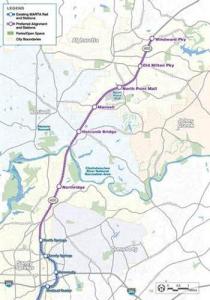MARTA Eyes Expansion into North Fulton County
 (APN) ATLANTA — It was a busy summer for the Metropolitan Atlanta Regional Transit Authority (MARTA), although not because riders were flocking to the new Ferris Wheel in downtown Atlanta. “Connect 400” informational sessions made their way around north Fulton County this summer, gathering opinions from residents about where the next phase of the North Springs rail line would go: east or west of 400?
(APN) ATLANTA — It was a busy summer for the Metropolitan Atlanta Regional Transit Authority (MARTA), although not because riders were flocking to the new Ferris Wheel in downtown Atlanta. “Connect 400” informational sessions made their way around north Fulton County this summer, gathering opinions from residents about where the next phase of the North Springs rail line would go: east or west of 400?
Currently, the furthermost north MARTA station is the North Springs Station, located at 7010 Peachtree Dunwoody Road, in Sandy Springs, although there is much more room for expansion: further north through Sandy Springs, through Roswell, and all the way up to Alpharetta.
“The [“Connect 400”] study aims to assess the opportunity for expanding high-capacity transit into northern Fulton County between the existing North Springs Station to Windward Parkway area, near the Forsyth County line,” Mark Eatman, MARTA Lead Planner for Connect 400 told Atlanta Progressive News.
The currently proposed map, obtained by APN, proposes the following stops: Northridge, Holcomb Bridge, Mansell, North Point Mall, Old Milton Parkway, and finally, Windward Parkway.
The MARTA line would have to stop there because Forsyth County does not participate in MARTA, which is a partnership between Fulton County, DeKalb County, and the City of Atlanta. [Clayton County voters are likely to approve a historic, binding referendum to join MARTA in next month’s General Election, in November 2014.]
MARTA has completed an alternatives analysis, conducted two public opinion surveys, held many public meetings, and most recently completed Early Scoping—an extensive community outreach effort as part of the federal planning process, Eatman said.
While public input is definitely needed and appreciated, in a region where public transportation has historically been looked down upon by the White affluent population, while deemed absolutely necessary by low-income minority populations, leaving this decision to public input could be problematic.
Reports abound from local news media, who spoke to north Fulton residents during MARTA info sessions. There are some who apparently still believe that criminals will ride an hour away on MARTA north to steal from them.
In addition, there were other concerns raised, including the possibility of schools and playgrounds being leveled to make way for the rail line.
Chip Swearngan, President of the Somerset Homeowners Association in Sandy Springs, presented results of a survey, with about 75 respondents, at an info session this summer 2014.
Most said essentially to ‘go west’ of GA 400 and don’t put a MARTA station at Northridge Road.
Swearngan, who wrote his side of the story in an Atlanta Journal-Constitution blog post, suggested using less National Parks Land in the west, and predicted that property values would appreciate; it was a magnanimous way to say keep off the east side’s grass.
Funding sources for “Connect 400” are inventive and highly competitive, according to Eatman.
“MARTA is hoping to qualify for the federal New Starts grant program. This program has a maximum match of fifty percent and is highly competitive. The other fifty percent, or more, would come from a local funding match,” Eatman said.
“Currently the MARTA penny sales tax is stretched about as far as it can go. We are looking into innovative design-build options that could bring costs savings and other alternative local funding sources, both public and private, to assist in meeting local match requirements,” Eatman said.
“Everyone wants it to happen,” Sandy Springs City Council Member Gabriel Sterling (District 4) told APN. “I’m skeptical about where the funding will come from because of the recession… the Council will be passing a resolution to support the expansion.”
It’s a 12/12 scenario, before Metro Atlantans see any rubber meeting the road: a twelve mile corridor taking about twelve years to complete.
As previously reported by APN, several MARTA heavy rail line expansions were proposed in the initial T-SPLOST project list for the Metro Atlanta area. The T-SPLOST was an additional penny sales tax, considered in 2012, but not adopted in the Metro Atlanta area.
In 2011, MARTA submitted proposals for T-SPLOST for an East Line, a West Line, and a Northeast Line. The Georgia Department of Transportation added a proposal for a North line that mirrors the current proposal.
However–due in part to heavy-handed lobbying by Atlanta Mayor Kasim Reed–the Atlanta Regional Roundtable cut all heavy rail expansion proposals from the final, “constrained” project wish list that was submitted to voters in 2012. The Roundtable replaced the line extensions with such projects as segments of streetcar transport on the controversial Atlanta Beltline; and a light rail project on a new east line.
[Editorial note: Atlanta Progressive News and other progressive groups opposed the Metro Atlanta T-SPLOST in 2012, but might have supported if had heavy rail line extensions been included instead of the Beltline gentrification project.]
According to MARTA planners, “MARTA was committed to this project prior to the 2012 T-SPLOST and remains committed to it after. We started our current effort back in 2011 and are still working to advance it through the federal planning process.”
(END/2014)